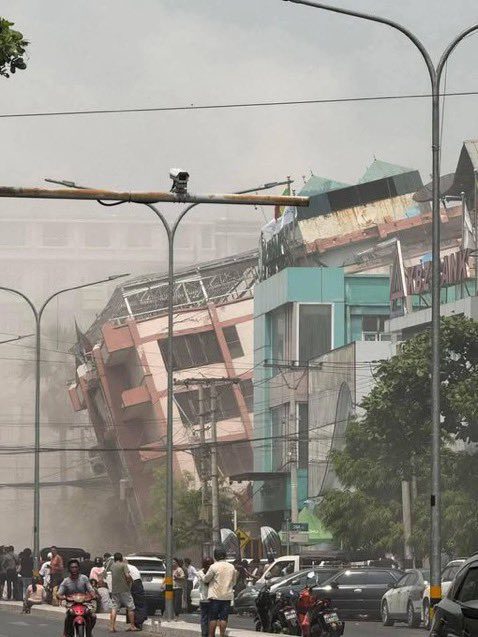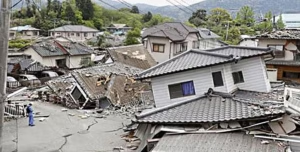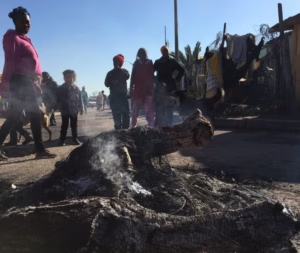A powerful magnitude 7.7 earthquake struck central Myanmar on Friday, leaving behind a trail of destruction and prompting urgent rescue operations across several countries in the region. The epicentre lay just northwest of the city of Sagaing, with tremors felt as far as 1,000 kilometres away in the Thai capital, Bangkok.
According to Myanmar’s ruling military administration, 1,644 lives have been lost while 3,408 individuals were injured in what is now considered one of the country’s most devastating seismic events in recent memory. The quake’s shallow depth compounded its destructive force, levelling infrastructure, severing transportation routes, and triggering chaos across urban and rural communities alike.
Mandalay, Myanmar’s second-largest city and one of the closest to the epicentre, bore the brunt of the destruction. The city, already under strain from ongoing internal conflict and limited resources, is now grappling with widespread infrastructural damage and a mounting humanitarian crisis.
Night of Fear and Displacement
In the capital city, Naypyidaw, many residents opted to sleep outdoors following the initial tremors.
“It was a pretty uncomfortable night for lots of people. They chose to sleep outside. We saw them in parks putting mattresses outside their homes,”
reported Tony Cheng of Al Jazeera.
He added that the fear persisted into the next day.
“There were still aftershocks, several we felt this morning. They were not significantly large ones, but enough to make people feel uncomfortable returning into built-up structures,”
he said.
More than 70 aftershocks were recorded within the first 24 hours following the quake. While the magnitude of these aftershocks was relatively minor compared to the initial event, they contributed to widespread anxiety among the public.
Relief Efforts Hindered by Infrastructure Collapse
The United Nations Office for the Coordination of Humanitarian Affairs (OCHA) raised concerns on Saturday over significant obstacles faced by aid organisations due to damaged infrastructure.
“Damage to the Yangon-Nay Pyi Taw-Mandalay expressway led to service disruptions, with cracks and surface distortions forcing highway buses to halt operations,”
the agency stated.
Bridges, roads, and key logistical arteries were severely affected, hindering the timely delivery of emergency assistance to hard-hit areas. In its assessment, OCHA noted that many regions remained inaccessible, with limited communications and fractured supply lines slowing the pace of relief.
Myanmar’s military also acknowledged the scale of the devastation, confirming that,
“Infrastructure such as roads, bridges, and buildings were affected, leading to casualties and injuries among civilians. Search and rescue operations are currently being carried out in the affected areas.”
A Rare Ceasefire Amid Crisis
In a move that underscores the gravity of the situation, the country’s shadow National Unity Government declared a unilateral two-week partial ceasefire beginning Sunday. The decision, which applies to earthquake-affected zones, is intended to allow humanitarian relief to proceed unimpeded.
“Collaborate with the U.N. and non-governmental organisations to ensure security, transportation, and the establishment of temporary rescue and medical camps,”
read a statement from the People’s Defence Force, the armed wing of the opposition.
The ceasefire is seen as an unprecedented gesture amid the country’s ongoing civil conflict, and international observers hope it will hold long enough to support the immediate needs of those affected by the earthquake.
Bangkok Reels as Aftershock Devastates Construction Site
In Thailand, nearly 1,000 kilometres from the quake’s epicentre, tragedy struck when a 30-storey skyscraper under construction collapsed in Bangkok, killing at least 10 people and trapping potentially scores more beneath rubble.
“We are doing our best with the resources we have because every life matters,”
said Bangkok Governor Chadchart Sittipunt at the site of the collapse.
“Our priority is acting as quickly as possible to save them all,”
he added, acknowledging that up to 100 workers remained unaccounted for.
Al Jazeera correspondent Imran Khan, reporting from the Thai capital, noted the rare experience of seismic activity in the city.
“People in Bangkok were not used to having earthquakes,”
he said.
“While they have not really been felt here in Bangkok, each report gets people very, very nervous. People are incredibly nervous that this might happen again.”
City authorities have since received over 2,000 damage reports and plan to deploy more than 100 engineers to inspect high-rise buildings for structural integrity.
Innovation Amid Tragedy: Robotic Assistance and Unprecedented Birth
Thai rescue teams deployed robotic mules to the ruins outside JJ Mall in the Chatuchak area of Bangkok, hoping to locate survivors and recover those trapped.
Meanwhile, a poignant story emerged from the city’s Police General Hospital, where a woman in labour had to be evacuated mid-surgery as tremors rocked the facility. Despite the chaos, doctors managed to deliver her baby safely on the street, surrounded by medical personnel.
“The patient was carried out of the hospital by medical teams and, surrounded by healthcare staff, gave birth to a baby boy,”
said Police Colonel Sirikul Srisanga, a hospital spokesperson.
International Support Begins to Arrive
India was among the first nations to respond to Myanmar’s crisis, dispatching emergency personnel and aid supplies.
“That request must trickle down to immigration and customs, so nongovernmental organisations like ourselves can get the immediate aid in there,”
said Harry Roberts, a volunteer with Shelterbox, a global disaster relief agency.
“At this stage, it’s largely about gathering information and assessing the accessibility into the country,”
Roberts added, noting the complicated nature of coordinating disaster relief under Myanmar’s current political conditions.
India’s initial consignment amounted to 137 tonnes of relief materials sent by both air and naval transport. Additional support is expected based on further assessments and requests from Myanmar’s government.

















